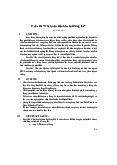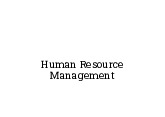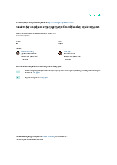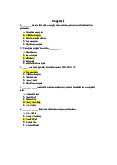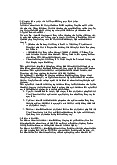








Preview text:
➢
Fair Treatment reflects concrete actions, such as “employees are treated
with respect,” and “employees are treated fairly.” ➢ a waiter,… Answer:
Job Descriptions: a list of a job’s duties, responsibilities, reporting relationships,
working conditions, and supervisory responsibilities—one product of a job analysis.
Job Specifications: a list of a job’s “human requirements,” that is, the requisite
education, skills, personality, and so on—another product of a job analysis.
Example of JD and JS? (-> homework) Answer:
- Job Analysis is the procedure for determining the duties and skill requirements of a
job and the kind of person who should be hired for it.
Methods for Collecting Job Analysis Information: The Interview Questionnaires Observation Participant Diary/Logs
Quantitative Job Analysis Techniques: The Position Analysis Questionnaire (PAQ)
Electronic Job Analysis Answer:
Internal sources of candidates: current employees or “hiring from within”.
External sources of candidates:
Recruiting via the Internet Advertising Employment Agencies
Offshoring and Outsourcing Jobs Executive Recruiters
Recruitment Process Outsourcers and On-Demand Recruiting Services (ODRS) Campus Recruiting Referral and Walk-Ins Military Personnel Answer:
Internal Recruitment: transferring/ promoting current employees or “hiring from within”. Answer:
Types of Questions
Situational questions focus on the candidate’s ability to explain what his or her
behavior would be in a given situation.
Behavioral questions: ask interviewees how they behaved in the past in some situation.
Knowledge and background questions probe candidates’ job-related knowledge and experience.
“Trick” questions (such as “What kind of animal would you be?”)
Provide at least 02 examples for each type (-> homework) Answer:
Employee Orientation is a procedure for providing new employees with basic
background information about the firm.
Why orientates employees?
Make the new employee feel welcome and at home and part of the team.
Make sure the new employee has the basic information to function effectively,
such as e-mail access, personnel policies and benefits, and expectations in terms of work behavior.
Help the new employee understand the organization in a broad sense (its past,
present, culture, and strategies and vision of the future).
Start socializing the person into the firm’s culture and ways of doing things. Answer:
On the job training: Training a person to learn a job while working on it.
Job Instruction Training: Listing each job’s basic tasks, along with key points, to
provide step-by-step training for employees.
Behavior Modeling: trainees are first shown good management techniques in a
film, are asked to play roles in a simulated situation, and are then given feedback and
praise by their supervisor. Answer:
Performance Appraisal is any procedure that involves (1) setting work standards; (2)
assessing the employee's actual performance relative to the standards; and (3)
providing feedback to the employee with the aim of motivating that person to
eliminate performance deficiencies or to continue the performance above par. Answer:
Why do we need to conduct performance appraisal?
First, most employers still base pay, promotion, and retention decisions on the
employee’s appraisal.
Second, appraisals play a central role in performance management.
Third, the appraisal lets you and the subordinate develop a plan for correcting
any deficiencies and to reinforce the things he or she does right.
Fourth, appraisals should provide an opportunity to review and recalibrate the
employee’s career plans in light of his or her exhibited strengths and weaknesses.
Finally, supervisors use appraisals to identify employees’ training and development needs.
Performance appraisals are conducted for several reasons:
Eliminate performance deficiencies/ to continue performance above the bar.
Assisting decision making in employees’ salary adjustments, merit raises, and incentive rewards.
Assisting decision making in the promotions, demotions, transfers,
terminations, and even layoffs of employees.
Identify employees’ training and development needs, and performance gap.
Who should do the appraising?
Peer appraisals: appraisals by one’s peers—are popular.
Rating committee: the employee’s immediate supervisor and three or four other supervisors.
Some employers obtain Employees’ self-ratings: along with supervisors’ ratings.
Many employers have Subordinates rate their managers, usually for
developmental rather than for pay purposes.
360-degree feedback: the employer collects performance information all
around an employee—from supervisors, subordinates, peers, and internal or external
customers—generally for developmental rather than pay purposes. Crowd Appraisals
… (-> in-class activity) Answer:
Employee Compensation are all forms of pay or rewards going to employees and
arising from their employment.
Direct financial payments: pay in the form of wages, salaries, incentives,
commissions, and bonuses.
Indirect financial payments: pay in the form of financial benefits such as insurance. Answer:
External equity refers to how a job’s pay rate in one company compares to the
job’s pay rate in other companies.
Internal equity refers to how fair a particular job’s pay rate is when compared
to other jobs within the same company.
Individual equity refers to the fairness of an individual’s pay as compared with
what his or her coworkers are earning for the same or very similar jobs within the
company, based on performance.
Procedural equity refers to the “perceived fairness of the processes and
procedures used to make decisions regarding the allocation of pay.”
NOTE: Case study questions involve mostly knowledge in Chapter 5,6,7 Getting Better Applicants
If you were to ask Jennifer and her father what the main problem was in running their
firm, their answer would be quick and short: hiring good people. Original y begun as a string of
coin-operated laundromats requiring virtual y no skil ed help, the chain grew to six stores, each
heavily dependent on skil ed managers, cleaner/spotters, and pressers. Employees general y have
no more than a high school education (often less), and the market for them is very competitive.
Over a typical weekend, literal y dozens of want ads for experienced pressers or cleaner/ spotters
can be found online or in area newspapers. Al these people usual y are paid around $15 per hour,
and they change jobs frequently. Jennifer and her father thus face the continuing task of
recruiting and hiring qualified workers out of a pool of individuals they feel are almost nomadic in
their propensity to move from area to area and job to job. Turnover in their stores (as in the
stores of many of their competitors) often approaches 400%. “Don’t talk to me about human
resources planning and trend analysis,” says Jennifer. “We’re fighting an economic war, and I’m
happy just to be able to round up enough live applicants to be able to keep my trenches fully manned.”
In light of this problem, Jennifer’s father asked her to answer the questions that fol ow. Questions
1. First, how would you recommend we go about reducing the turnover in our stores?
2. Provide a detailed list of recommendations concerning how we should go about increasing our
pool of acceptable job applicants so we no longer face the need to hire almost anyone who walks
in the door. (Your recommendations regarding the latter should include completely worded
online and hard-copy advertisements and recommendations regarding any other recruiting
strategies you would suggest we use.) (-> homework)
Honesty Testing at Carter Cleaning Company
Jennifer Carter and her father have what the latter describes as an easy but hard job
when it comes to screening job applicants. It is easy because for two important jobs—the people
who actual y do the pressing and those who do the cleaning-spotting—the applicants are easily
screened with about 20 minutes of on-the-job testing. As with typists, as Jennifer points out,
“Applicants either know how to press clothes fast enough or how to use cleaning chemicals and
machines, or they don’t, and we find out very quickly by just trying them out on the job.” On the
other hand, applicant screening for the stores can also be frustratingly hard because of the nature
of some of the other qualities that Jennifer would like to screen for. Two of the most critical
problems facing her company are employee turnover and employee honesty. Jennifer and her
father sorely need to implement practices that wil reduce the rate of employee turnover. If there
is a way to do this through employee testing and screening techniques, Jennifer would like to
know about it because of the management time and money that are now being wasted by the
never-ending need to recruit and hire new employees. Of even greater concern to Jennifer and
her father is the need to institute new practices to screen out those employees who may be
predisposed to steal from the company.
Employee theft is an enormous problem for Carter Cleaning Centers, and one that is not
just limited to employees who handle the cash. For example, the cleaner-spotter and/or the
presser often open the store themselves, without a manager present, to get the day’s work
started, and it is not unusual to have one or more of these people steal supplies or “run a route.”
Running a route means that an employee canvasses his or her neighborhood to pick up people’s
clothes for cleaning and then secretly cleans and presses them in the Carter store, using the
company’s supplies, gas, and power. It would also not be unusual for an unsupervised person (or
his or her supervisor, for that matter) to accept a 1-hour rush order for cleaning or laundering,
quickly clean and press the item, and return it to the customer for payment without making out a
proper ticket for the item posting the sale. The money, of course, goes into the worker’s pocket
instead of into the cash register.
The more serious problem concerns the store manager and the counter workers who
actual y handle the cash. According to Jack Carter, “You would not believe the creativity
employees use to get around the management controls we set up to cut down on employee
theft.” As one extreme example of this felonious creativity, Jack tel s the fol owing story: “To cut
down on the amount of money my employees were stealing, I had a smal sign painted and placed
in front of al our cash registers. The sign said: YOUR ENTIRE ORDER FREE IF WE DON’T GIVE YOU
A CASH REGISTER RECEIPT WHEN YOU PAY. CALL 552–0235. It was my intention with this sign to
force al our cash-handling employees to place their receipts into the cash register where they
would be recorded for my accountants. After al , if al the cash that comes in is recorded in the
cash register, then we should have a much better handle on stealing in our stores, right? Wel ,
one of our managers found a diabolical way around this. I came into the store one night and
noticed that the cash register this particular manager was using just didn’t look right, although the
sign was dutiful y placed in front of it. It turned out that every afternoon at about 5:00 p.m., when
the other employees left, this character would pul his own cash register out of a box that he hid
underneath our supplies. Customers coming in would notice the sign and of course the fact that
he was meticulous in ringing up every sale. But unknown to them and us, for about five months,
the sales that came in for about an hour every day went into his cash register, not mine. It took us
that long to figure out where our cash for that store was going.” Jennifer would like you to answer the fol owing questions. Questions
1. What would be the advantages and disadvantages to Jennifer’s company of routinely
administering honesty tests to al its employees?
2. Specifical y, what other screening techniques could the company use to screen out theft prone
and turnover-prone employees, and how exactly could these be used?
3. How should Jennifer’s company terminate employees caught stealing, and what kind of
procedure should be set up for handling reference cal s about these employees when they go to
other companies looking for jobs? (-> homework)
Carter Cleaning Company: The New Training Program
The Carter Cleaning Centers currently have no formal orientation or training policies or
procedures, and Jennifer believes this is one reason why the standards to which she and her
father would like employees to adhere are general y not fol owed.
The Carters would prefer that certain practices and procedures be used in dealing with
the customers at the front counters. For example, al customers should be greeted with what Jack
refers to as a “big hel o.” Garments they drop off should immediately be inspected for any
damage or unusual stains so these can be brought to the customer’s attention, lest the customer
later return to pick up the garment and erroneously blame the store. The garments are then
supposed to be immediately placed together in a nylon sack to separate them from other
customers’ garments. The ticket also has to be carefully written up, with the customer’s name and
telephone number and the date precisely and clearly noted on al copies. The counter person is
also supposed to take the opportunity to try to sel the customer additional services such as
waterproofing, or simply notify the customer that, “Now that people are doing their spring
cleaning, we’re having a special on drapery cleaning al this month.” Final y, as the customer
leaves, the counter person is supposed to make a courteous comment like “Have a nice day” or
“Drive safely.” Each of the other jobs in the stores—pressing, cleaning and spotting, and so
forth—similarly contain certain steps, procedures, and most importantly, standards the Carters would prefer to see upheld.
Jennifer thinks the company has had problems because of a lack of adequate employee
training and orientation. For example, two new employees became very upset last month when
they discovered that they were not paid at the end of the week, on Friday, but instead were paid
(as are al Carter employees) on the fol owing Tuesday. The Carters use the extra two days in part
to give them time to obtain everyone’s hours and compute their pay. The other reason they do it,
according to Jack, is that, “Frankly, when we stay a few days behind in paying employees, it helps
to ensure that they at least give us a few days’ notice before quitting on us. While we are certainly
obligated to pay them anything they earn, we find that psychological y they seem to be less likely
to just walk out on us Friday evening and not show up Monday morning if they stil haven’t gotten
their pay from the previous week. This way they at least give us a few days’ notice so we can find a replacement.”
There are other matters that could be covered during orientation and training, says
Jennifer. These include company policy regarding paid holidays, lateness and absences, health
benefits (there are none, other than workers’ compensation), substance abuse, eating or smoking
on the job (both forbidden), and general matters like the maintenance of a clean and safe work
area, personal appearance and cleanliness, time sheets, personal telephone cal s, and personal e- mail.
Jennifer believes that implementing orientation and training programs would help to
ensure that employees know how to do their jobs the right way. And she and her father further
believe that it is only when employees understand the right way to do their jobs that there is any
hope their jobs wil be accomplished the way the Carters want them to be accomplished. Questions
1. Specifical y, what should the Carters cover in their new employee orientation program, and
how should they convey this information?
2. In the HR management course Jennifer took, the book suggested using a job instruction sheet
to identify tasks performed by an employee. Should the Carter Cleaning Centers use a form like
this for the counter person’s job? If so, what should the form look like, say, for a counter person?
3. Which specific training techniques should Jennifer use to train her pressers, her
cleaner/spotters, her managers, and her counter people? Why should these training techniques
be used? (-> homework)
